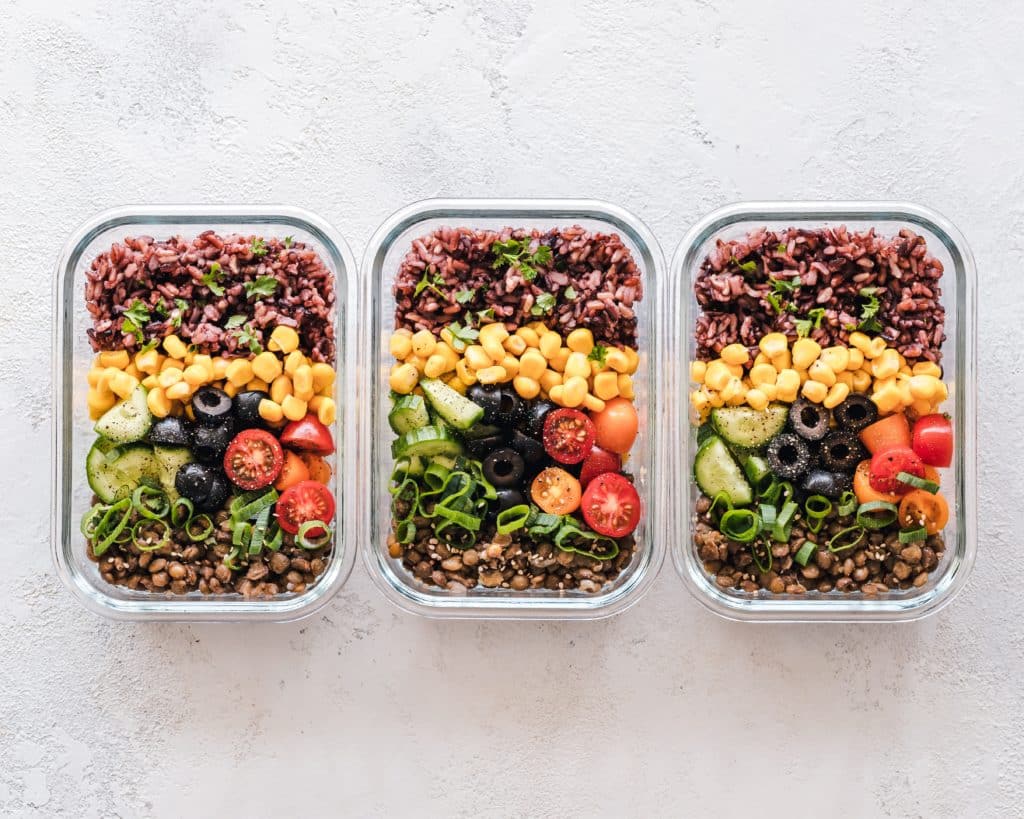How to Make a Healthy Meal Plan on a Budget

There’s no denying it. Meal planning takes work. And when you are on a strict budget and want to make healthy meals for your family, meal planning may seem daunting.
But creating a healthy meal plan your family will love is possible, even when your funds are limited. The key is to combine concepts of healthy eating and money-saving strategies during the meal planning process. This guide will help you integrate these three things to conquer mealtime in no time.
Table of Contents
How to Create a Healthy Meal Plan Successfully
The first step in creating a healthy meal plan for your family is committing to regular meal planning. Here are tips to help you stick to meal planning for long-term success.
Find a Meal Planning System
If you want to start feeding your family healthy meals regularly, you’ll want to find a meal planning system that works for you. Consistency will become much easier once you figure out the most efficient way to create your healthy meal plan.
Here are the two main questions you’ll need to answer to develop your plan for healthy meals.
How often will you meal plan for your family? Many people find weekly meal planning to be the easiest. However, if finding time to meal plan every week is challenging, biweekly or monthly meal planning may be better.
Where will you write down your meals? A meal planning binder is an excellent tool for staying organized. However, it’s not the only solution for keeping track of your family’s meals. You could use an inexpensive planner, a decorative chalkboard in your kitchen, or even a piece of paper. The important thing is to figure out what works for you.
Keep a List of Simple and Healthy Meals
To stick to meal planning for the long-term and maintain healthy eating habits for your family, you will want to have a list of nutritious yet simple dinner ideas you can refer to when choosing meals. In addition, preparing easy meals on a busy night will help avoid resorting to unhealthy takeout and fast food.
When you find a simple and healthy meal that’s a hit with your family, don’t forget to write it down. Keep the list in a convenient spot to pull it out when it’s time to meal plan. Then, as your list of your family’s favorite meals grows, you can use it as a resource to help create your healthy meal plans more quickly.
Keep a Routine
After you have decided on your meal planning system, you will want to incorporate meal planning into your schedule. For example, if you are going to meal plan once a week, you’ll want to designate time each week to complete it. Doing your meal planning around the same time each week will help you stay consistent with creating a healthy meal plan for your family.
Think about your current schedule and the amount of time you have available to devote to meal planning. If you are busy with work and your kids’ activities during the week, monthly meal planning may be ideal because you only need to think about it once a month. Got more time on your hands? Weekly meal planning may be the way to go.
Decide When to Grocery Shop
Another important decision you will need to make for successful meal planning is when to shop for groceries. If you are meal planning every week, you’ll need to head to the grocery store every week after making your meal plan.
However, if you decide to plan your meals every other week (biweekly) or once a month, you’ll have more flexibility with grocery shopping. If you create a biweekly meal plan, you can choose to do your food shopping every week or every other week. If you create a monthly meal plan, you can choose to do your grocery shopping weekly, biweekly, or monthly.
The Core Concepts of a Healthy Meal Plan
Creating a healthy meal plan is the same as making any meal plan. However, the difference is in your meal choices and how you prepare your food. Choosing healthy foods and preparing those foods to maintain their nutritional qualities is essential for a healthy meal. Here are some tips to make your meal plan healthy.
Buy Lean Meats
Lean meats are meats that have a lower fat content. Skinless chicken and turkey, pork, lamb, veal, and fish are considered lean meats. Even ground beef is regarded as lean meat when you choose 90% lean or higher.
If you buy a cut of meat with visible fat on it, trim off the excess before preparing it. Budget-friendly lean cuts of meat include bone-in pork loin chops, beef sirloin, lean ground beef, bone-in chicken, and flat-iron steak.
Limit Foods High in Saturated Fats
Saturated fats are a type of unhealthy fat found in food. Eat foods that are high in saturated fats sparingly for healthy eating.
Some examples of food products that contain saturated fats are:
- Fried Foods (Chicken, Battered Fish, French Fries)
- Prepackaged Baked Goods (Cookies, Pastries)
- Margarine
- Frozen Pizza
- Meat Sticks
- Frozen Dinners
- Doughnuts
- Coffee Creamers
- Frosting
The best way to identify foods high in saturated fat is to read labels. Look for the Nutrition Facts label on the product to check for the number of grams of saturated fat.
The American Heart Association recommends no more than 6% of the calories you eat be from saturated fats. So, for example, if you consume 2,000 calories a day, you should keep the amount of saturated fat you eat to less than 13 grams a day.
Eat Your Fruits and Veggies
Fruits and vegetables are essential for a healthy diet. However, some fruits and vegetables are more beneficial than others. Therefore, when making your healthy meal plan, you will want to include as many healthier options as possible. Here are the most nutritiously dense fruits and veggies and the less nutritious options.
Healthiest fruits and vegetables:
- Avocados
- Tomatoes
- Citrus Fruits
- Sweet Potatoes
- Blueberries
- Kale
- Spinach
- Carrots
Least healthy fruits and vegetables:
- Celery
- Dried Fruit
- Corn
- Radishes
- Eggplant
- Iceberg Lettuce
- Russet Potatoes
Know Proper Portion Sizes
Controlling the amount of food you eat is just as important as what you eat. You should base the number of calories you will need to consume on how active your lifestyle is. In addition, you’ll want to consider any weight goals you or family members have when determining caloric intake.
As a general rule of thumb, a person who eats a 2,000-calorie diet should include:
- Two and a Half Servings of Vegetables
- Two Servings of Fruits
- Six Servings of Grains
- Three Servings of Dairy
- Six One-Once Servings of Lean Meat/Protein
Be Mindful of How You Prepare Your Food
Preparing your food to avoid adding unnecessary calories and fat is essential for healthy meal planning. Unfortunately, it is easy to turn healthy food into an unhealthy meal during the cooking process.
Avoid deep frying foods and sautéing foods in oils. Steaming, baking, grilling, and roasting are all healthier cooking methods. Use non-stick cookware to avoid the need to coat food with oil. Instead of boiling vegetables, steam or microwave them to keep their beneficial nutrients intact. Use low-fat versions of ingredients instead of full-fat versions (cheese, milk, sour cream, dressings, etc.).
Money-Saving Tips for Creating a Healthy Meal Plan on a Budget
The third component of creating a healthy meal plan on a budget is saving money on your food. There are numerous money-saving strategies and life hacks to reduce your grocery expenses. In addition, many cheap foods are also some of the healthiest options to include in your meal plan.
Meal Plan Around Sales
Ideally, you’ll want to check your pantry, fridge, and freezer for food that’s about to expire to meal plan around what you already have. Using up what you have first will help you avoid food waste and help lower your grocery bill.
Check your grocery store ads for sales once you plan meals around what you have on hand. Then, plan the remainder of your meals based on foods on sale that week.
Use Your Leftovers
Leftovers are excellent for helping your money go further. Buying a larger quantity of food for one meal can be cheaper than buying the food needed for several different meals. Integrate leftovers into your healthy meal plan by cooking up large batches of meals to either use within the same meal plan or freeze to use in the future.
There are many ways to use up leftovers, even if you don’t have enough of them to feed your family a second time. Here are some ways you can incorporate leftovers into other meals:
- Eat leftovers as a side dish for another meal
- Add leftovers to a casserole or soup
- Use leftover meat to make a sandwich or add it to a garden salad
- Make an omelet with your leftover veggies and meats
- Use your leftovers as homemade pizza toppings
- Add leftovers to quesadillas or fajitas
Use In-Season Produce
Produce is expensive, especially if it’s not in season. Strive to use seasonal produce in your meal plan. Check the frozen aisle first if you need out-of-season produce for a particular recipe. Frozen fruits and vegetables are as healthy as the fresh versions and are typically cheaper.
Buy in Bulk
Buying food in bulk when you find it at rock bottom prices can save you money in the long run. If you plan to buy in bulk, keep a list of the food you frequently purchase and the food’s lowest price to help you spot deals.
However, only buy food you know you will use or freeze before expiration to avoid food waste. When shopping at a membership warehouse club, check the unit price before purchasing and compare it to your lowest price list to ensure you are getting a deal.
Eat One Meatless Meal Per Week
Meat is typically the most expensive part of any meal. If you are trying to keep food costs low and make cheap meals for your family, eliminating meat from at least one meal a week can help.
But be sure to keep your meals healthy by replacing the meat with equally nutritious food. When you omit meat from a meal, you cut out essential protein. Add protein back into your diet with these protein-rich foods:
- Lentils
- Beans
- Tofu
- Jackfruit
- Nuts and Nut Butters
- Seeds
- Mushrooms
- Quinoa
- Cottage Cheese
- Oats
Final Thoughts on Making a Budget-Friendly Healthy Meal Plan
It is possible to feed your family affordable, nutritious meals. Building a healthy meal plan does take effort. But when you have a sound meal planning system in place, all you need is a basic understanding of healthy eating to make the right food choices. Then, use some of the money-saving strategies discussed above to reduce your food costs, and you will have a healthy meal plan on a budget your family will love.
This post originally appeared on Hello Sensible.
Originally posted 2022-06-21 03:47:54.
Megan Santiago
Latest posts by Megan Santiago (see all)
- How to Find a Trauma Therapist in Tampa - September 30, 2024
- The Best Essential Oils for Adrenal Fatigue - March 10, 2024
- The Best Ashwagandha Supplement – It Works Fast - March 10, 2024
